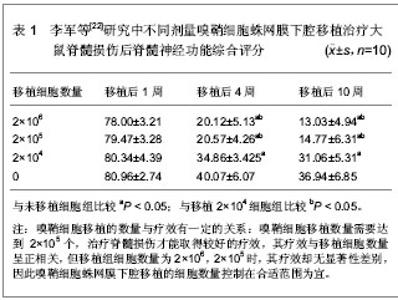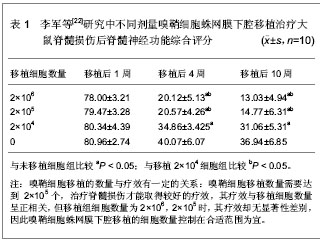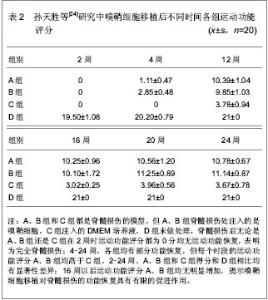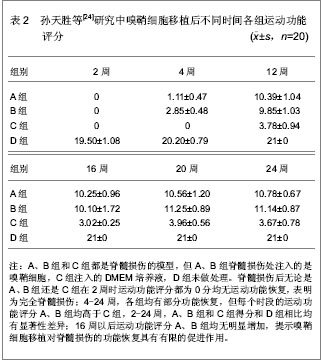Chinese Journal of Tissue Engineering Research
Previous Articles Next Articles
Olfactory ensheathing cell transplantation repairs spinal cord injury
Hou Xiao-feng
- Department of Neurosurgery, Wuwei People’s Hospital, Wuwei 733000, Gansu Province, China
-
Received:2013-01-10Revised:2013-05-20Online:2013-07-30Published:2013-07-30 -
About author:Hou Xiao-feng, Associate chief physician, Department of Neurosurgery, Wuwei People’s Hospital, Wuwei 733000, Gansu Province, China houxiaofengdoctor@163.com
CLC Number:
Cite this article
Hou Xiao-feng. Olfactory ensheathing cell transplantation repairs spinal cord injury[J]. Chinese Journal of Tissue Engineering Research, doi: 10.3969/j.issn.2095-4344.2013.31.018.
share this article

2 嗅鞘细胞移植修复脊髓损伤 2.1 嗅鞘细胞移植治疗脊髓损伤的实验基础研究 2.1.1 嗅鞘细胞移植治疗脊髓损伤的国外实验基础研究 2000年,Ramón-Cueto等[10]进行了将嗅鞘细胞移植入脊髓被完全横断的成年大鼠的实验,发现在移植以后四肢瘫痪的大鼠能够自发的活动后肢,适当的放置四肢来支撑身体质量,而且还获得了轻微的触觉和本体感觉。2006年,Lu等[11]在大鼠完全脊髓横断损伤4周,移植入嗅固有层损伤区域,10周后接受移植的动物能够移动后肢,并在组织学上表现出脑干-5羟色胺神经元再生依据,但在接受呼吸固有层移植的动物身上无此发现,此实验为使用鼻黏膜嗅鞘细胞作用于脊髓损伤的修复建立了可行性。2003年,Ruitenberg等[12]将腺病毒载体介导的脑源性神经营养因子、神经营养素3目的基因修饰的嗅鞘细胞移植到经切断的单侧第4颈髓背外侧束损伤脊髓处,移植4个月后病变脊髓体积明显缩小,病变处充满了神经胶质纤维细丝阳性轴突,并且移植经基因修饰的嗅鞘细胞,明显促进了红核脊髓束的再生和轴突发芽,而且还能促进后肢功能的恢复。 2.1.2 嗅鞘细胞移植治疗脊髓损伤的国内实验基础研究 2002年,曹莉等[13]建立成年大鼠脊髓T8半横断损伤模型,将体外培养纯化的嗅鞘细胞移植入脊髓损伤处,同时局部应用外源性胶质细胞源性神经营养因子。发现联合应用时对皮质和红核神经元有逆行性保护作用,可促进脊髓下行传到束再生,肢体运动功能恢复,证实联合应用外源性胶质细胞源性神经营养因子和嗅鞘细胞在脊髓损伤修复治疗中具有协同作用。 2006年,吴军等[14]观察神经营养素3基因转染嗅鞘细胞移植对急性大鼠脊髓损伤的作用。将自行构建的质粒pEGFP-NT3应用脂质体介导的方法导入体外培养的嗅鞘细胞,并移植入急性脊髓损伤大鼠体内,连续观察12周,与接受单纯嗅鞘细胞、空白质粒转染嗅鞘细胞移植的脊髓损伤大鼠进行比较。结果显示嗅鞘细胞是脊髓损伤基因治疗较好的受体细胞,转染神经营养素3基因的嗅鞘细胞移植后可以在体内较长时间存活,能明显促进急性脊髓损伤神经纤维的再生和功能恢复,为基因修饰嗅鞘细胞在脊髓损伤治疗中的应用提供了实验和理论依据。 2007年,蔡中续等[15]探讨大鼠嗅黏膜嗅鞘细胞移植联合神经生长因子修复脊髓急性损伤的可行性和疗效,并观察二者的协同作用。结果发现嗅鞘细胞移植可以明显促进轴突,嗅鞘细胞联合神经生长因子具有良好的脊髓损伤修复作用,且二者具有明显的协同作用。 2.2 嗅鞘细胞移植治疗脊髓损伤的临床研究 随着嗅鞘细胞成功应用于脊髓损伤的基础实验研究,特别是动物模型实验,研究者们已经掌握了一定的方法进行临床研究,人们逐渐将重心转移至探讨嗅鞘细胞在临床方面的应用价值。 2.2.1 嗅鞘细胞移植治疗脊髓损伤的国外临床研究 2005年,Féron等[16]在Ⅰ期临床试验中,对3例男性截瘫患者进行嗅鞘细胞移植,细胞来自嗅黏膜活检,并经体外纯化培养,植入1年后未出现治疗并发症,也没有脊髓的进一步损伤以及囊肿、肿瘤、瘘管的形成,进而认为自体嗅鞘细胞移植是安全可行的,并且计划对受试者进行3年随访,观察神经功能和精神状态的变化,以确认移植的长期安全性。2006年,Dobkin等[17]观察了7例在中国接受了嗅鞘细胞移植治疗的脊髓损伤患者,进行了治疗前、治疗后的比较,认为嗅鞘细胞移植治疗脊髓损伤的技术还不健全,而且患者在嗅鞘细胞移植治疗后功能上的恢复没有进步和改善,还存在一系列的并发症,整个治疗不能达到国际上安全、有效的标准,暂时不主张患者进行嗅鞘细胞移植治疗。因此,目前对于临床上的嗅鞘细胞移植治疗脊髓损伤,还存在一定的争议。 2008年,Mackay-Sim等[17]报道了应用嗅黏膜嗅鞘细胞移植到6例外伤性胸椎损伤后6个月-3年患者的受损部位,通过为期3年的临床研究,对自体嗅鞘细胞移植治疗截瘫患者进行了评估,36个月后6例患者的浅触觉和刺痛敏感性有所提高,但还没有明显的运动功能和神经性疼痛,第3年神经系统磁共振成像与第1、2年比较没有改变,未发现有诱导的肿瘤、继发性脊髓空洞症及异常影像学改变。目前,临床研究治疗的病例数少,随访时间短,只能是一个初步的结果,要考虑到各种有可能的不良后果,有待今后进一步的研究探索。 2.2.2 嗅鞘细胞移植治疗脊髓损伤的国内临床研究 2006年,黄红云等[18]对其Ⅰ期临床实验做了磁共振成像3年随访,结果未发现在注射部位及其临近区域有肿瘤或新生物生长,尽管个别患者有部分损伤平面以下神经功能恢复迹象,但其临床效果尚需长期随访观察。2007年,陈琳等[19]对晚期脊髓损伤患者进行胚胎嗅鞘细胞移植后的电生理评价表明,199例晚期完全性脊髓损伤患者治疗后肌电图检查46.7%显示部分受累肌肉大力收缩时运动单位电位数量增加,45.2%显示感觉平面下降。因此,认为对于胚胎嗅鞘细胞移植治疗晚期脊髓损伤患者,肌电图和椎旁躯体感觉诱发电位这两种电生理检查能较为客观的反映脊髓损伤临床治疗后感觉和运动功能恢复情况。 在嗅鞘细胞移植治疗脊髓损伤的临床研究中,应关注以下几个问题。明确限定临床研究入选病例及排除病例的标准;明确移植嗅鞘细胞的来源、类型及植入方法;建立客观有效的评估标准,科学评估临床试验治疗的有效性;开展多中心研究。 2.3 影响嗅鞘细胞移植治疗脊髓损伤的预后因素 2.3.1 嗅鞘细胞移植数量对其治疗脊髓损伤的预后影响 近年来,嗅鞘细胞移植治疗脊髓损伤的基础及临床研究较多[20-21],但对其移植数量与疗效的关系的研究报道较少。李军等[22]探讨了嗅鞘细胞蛛网膜下腔移植治疗脊髓损伤细胞移植数量与疗效的关系。应用改良Allen's法制备大鼠T10脊髓损伤模型,随机分4组,大剂量嗅鞘细胞蛛网膜下腔移植组(A组,2×106个)、中剂量嗅鞘细胞蛛网膜下腔移植组(B组,2×105个)、小剂量嗅鞘细胞蛛网膜下腔移植组(C组,2×104个)、DMEM/F12培养液蛛网膜下腔移植组(D组)。造模后即刻进行细胞移植,治疗后第1,4,10周行脊髓神经功能综合评分[23],对每组大鼠随机取10只分别进行肢体运动功能评分,评估脊髓功能恢复情况,100分表示下肢功能完全丧失,0分表示正常。结果脊髓神经功能综合评分显示A、B两组明显好于C、D两组(P < 0.05);A、B两组间比较差异无显著性意义,C、D两组间比较差异无显著性意义(P > 0.05),见表1。"


2.3.2 不同时间移植嗅鞘细胞对损伤脊髓功能恢复的影响 孙天胜等[24]研究了嗅鞘细胞移植后在体内存活情况以及对大鼠脊髓损伤长期的修复作用。将新生Wistar大鼠嗅球做嗅鞘细胞培养,大量增殖并标记。80只大鼠随机分为4组,每组20只。A、B、C组以质量为10 g,下落高度为25 mm的打击棒打击T13脊髓致运动诱发电位和体感诱发电位完全消失。A组在打击区中央用尖刀横行切断脊髓;D组仅做与A、B组相同节段的椎板减压,不挫伤脊髓;A、B组在脊髓远近断端距离挫伤区边缘1 mm的脊髓中线上,深度分别为1.75,1.5,1.0,0.5 mm处,各注入2×105个嗅鞘细胞;C组用同样的方法注射等量的高糖培养液;D组不做处理。分别在治疗后2,4,12,16,20和24周观察各组大鼠的神经功能恢复情况,行为学检测参照Basso等提出的大鼠脊髓损伤后功能评判标准进行神经功能评定[25-26]。结果脊髓损伤后A、B、C组大鼠后肢无任何运动功能,运动功能评分均为0分;4周后3组得分逐渐增高,A、B组在各时间段得分均高于C组(P < 0.01);16周后运动功能评分无显著增加,呈一平台期;至24周时A、B两组的评分在11分左右,12周作用C组的评分在3或4分,在各个时间段,3组得分与D组相比差异均有显著性意义(P < 0.01),见表2。"

| [1] Corti S,Locatelli F,Papadimitriou D,et al.Somatic stem cell research for neural repair: current evidence and emerging perspectives.J Cell Mol Med.2004;8(3):329-337.[2] Skinner AP,Pachnicke S,Lakatos A,et al.Nasal and frontal sinus mucosa of the adult dog contain numerous olfactory sensory neurons and ensheathing glia.Res Vet Sci.2005; 78(1):9-15.[3] Barnett SC,Chang L.Olfactory ensheathing cells and CNS repair: going solo or in need of a friend?Trends Neurosci. 2004;27(1):54-60.[4] Radtke C,Lankford KL,Wewetzer K,et al.Impaired spinal cord remyelination by long-term cultured adult porcine olfactory ensheathing cells correlates with altered in vitro phenotypic properties.Xenotransplantation.2010;17(1):71-80.[5] Li Y,Field PM,Raisman G.Repair of adult rat corticospinal tract by transplants of olfactory ensheathing cells.Science. 1997; 277(5334):2000-2002.[6] Senior K.Olfactory ensheathing cells to be used in spinal-cord repair trial.Lancet Neurol.2002;1(5):269.[7] 黄红云,王洪美,陈琳,等.嗅鞘细胞移植治疗晚期脊髓损伤临床试验初步报告[J].立体定向和功能性神经外科杂志,2004,17(6): 348-350.[8] 中国知网.中国学术期刊总库[DB/OL].2013-3-27. https://www.cnki.net[9] SCI数据库.Web of Sciencevia ISI Web of Knowledge[DB/OL]. 2013-3-27.http://ip-science.thomsonreuters.com/mjl[10] Ramón-Cueto A,Cordero MI,Santos-Benito FF,et al.Functional recovery of paraplegic rats and motor axon regeneration in their spinal cords by olfactory ensheathing glia.Neuron.2000;25(2):425-435.[11] Lu J,Féron F,Mackay-Sim A,et al.Olfactory ensheathing cells promote locomotor recovery after delayed transplantation into transected spinal cord.Brain.2002;125(1):14-21.[12] Ruitenberg MJ,Plant GW,Hamers FP,et al.Ex vivo adenoviral vector-mediated neurotrophin gene transfer to olfactory ensheathing glia: effects on rubrospinal tract regeneration, lesion size, and functional recovery after implantation in the injured rat spinal cord.J Neurosci.2003;23(18):7045-7058.[13] 曹莉,叶俊丽,刘丽,等.嗅鞘细胞移植联合应用GDNF对大鼠脊髓损伤的治疗作用[J].第二军医大学学报,2002,23(6):593-597.[14] 吴军,孙天胜,王献章,等.神经营养素-3基因修饰嗅鞘细胞移植对急性脊髓损伤作用的实验研究[J].中国脊柱脊髓杂志,2006, 16(2):147-151.[15] 蔡中续,李玉华,祁磊,等.嗅粘膜源性嗅鞘细胞移植联合NGF对脊髓损伤的修复[J].山东大学学报(医学版),2007,45(5):470-473.[16] Féron F,Perry C,Cochrane J,et al.Autologous olfactory ensheathing cell transplantation in human spinal cord injury.Brain.2005;128(12):2951-2960.[17] Mackay-Sim A,Féron F,Cochrane J,et al.Autologous olfactory ensheathing cell transplantation in human paraplegia: a 3-year clinical trial.Brain.2008;131(9):2376-2386.[18] 黄红云,王洪美,陈琳,等.胚胎嗅鞘细胞移植治疗晚期脊髓损伤影响功能恢复的因素[J].中国修复重建外科杂志,2006,20(4): 434-438.[19] 陈琳,黄红云,王援朝,等.晚期脊髓损伤患者胚胎嗅鞘细胞移植后的电生理评价[J].中国组织工程研究与临床康复,2007,11(24): 4738-4741.[20] 叶超群,孙天胜,高尔镜,等.同方法共移植的嗅鞘细胞和雪旺氏细胞在损伤脊髓内的迁移和对轴突再生的影响[J].中国脊柱脊髓杂志,2010,20(2):138-145.[21] 钟环,蔡小娴,陈继铭.NTFs基因修饰的人胚OECs植入促进大鼠SCI神经再生及功能恢复的研究[J].中国医疗前沿,2009, 4(6): 13-14.[22] 李军,魏开斌,刘红,等.不同剂量嗅鞘细胞蛛网膜下腔移植修复脊髓损伤的实验研究[J].中国脊柱脊髓杂志,2011,21(11):929-933.[23] Hara M,Takayasu M,Watanabe K,et al.Protein kinase inhibition by fasudil hydrochloride promotes neurological recovery after spinal cord injury in rats.J Neurosurg.2000; 93(1):94-101.[24] 孙天胜,任继鑫,史建国.嗅鞘细胞移植促进急性脊髓损伤的修复作用[J].中国医学科学院学报,2005,27(2):143-147.[25] Basso DM,Beattie MS,Bresnahan JC.A sensitive and reliable locomotor rating scale for open field testing in rats.J Neurotrauma.1995;12(1):1-21.[26] Basso DM,Beattie MS,Bresnahan JC,et al.MASCIS evaluation of open field locomotor scores: effects of experience and teamwork on reliability. Multicenter Animal Spinal Cord Injury Study.J Neurosurg.1996;13(7):343-359.[27] Jarmundowicz W,Tabakow P,Czapiga B,et al.Olfactory glial cells: hope in the treatment of spinal cord injuries.Neurol Neurochir Pol.2004;38(5):413-420.[28] Mothe AJ,Kulbatski I,van Bendegem RL,et al.Analysis of green fluorescent protein expression in transgenic rats for tracking transplanted neural stem/progenitor cells.J Histochem Cytochem.2005;53(10):1215-1226.[29] 陈莉发,段朝霞,张洁元.嗅鞘细胞移植到损伤脊髓存活时间的研究[J].成都医学院学报,2010,5(3):190-192.[30] 魏开斌,刘爱华,孙卫山.成年大鼠嗅球成鞘细胞的原代培养及形态学研究[J].中国矫形外科杂志,2004,12(20):1561-1564.[31] 段朝霞,张洁元,陈莉华.嗅鞘细胞移植后脊髓挫伤大鼠几种神经营养因子的表达变化[J].成都医学院学报,2010,5(3):185-189. |
| [1] | Jiang Hongying, Zhu Liang, Yu Xi, Huang Jing, Xiang Xiaona, Lan Zhengyan, He Hongchen. Effect of platelet-rich plasma on pressure ulcers after spinal cord injury [J]. Chinese Journal of Tissue Engineering Research, 2021, 25(8): 1149-1153. |
| [2] | Wan Ran, Shi Xu, Liu Jingsong, Wang Yansong. Research progress in the treatment of spinal cord injury with mesenchymal stem cell secretome [J]. Chinese Journal of Tissue Engineering Research, 2021, 25(7): 1088-1095. |
| [3] | Kong Desheng, He Jingjing, Feng Baofeng, Guo Ruiyun, Asiamah Ernest Amponsah, Lü Fei, Zhang Shuhan, Zhang Xiaolin, Ma Jun, Cui Huixian. Efficacy of mesenchymal stem cells in the spinal cord injury of large animal models: a meta-analysis [J]. Chinese Journal of Tissue Engineering Research, 2021, 25(7): 1142-1148. |
| [4] | Fan Quanbao, Luo Huina, Wang Bingyun, Chen Shengfeng, Cui Lianxu, Jiang Wenkang, Zhao Mingming, Wang Jingjing, Luo Dongzhang, Chen Zhisheng, Bai Yinshan, Liu Canying, Zhang Hui. Biological characteristics of canine adipose-derived mesenchymal stem cells cultured in hypoxia [J]. Chinese Journal of Tissue Engineering Research, 2021, 25(7): 1002-1007. |
| [5] | Wang Feng, Zhou Liyu, Saijilafu, Qi Shibin, Ma Yanxia, Wei Shanwen. CaMKII-Smad1 promotes axonal regeneration of peripheral nerves [J]. Chinese Journal of Tissue Engineering Research, 2021, 25(7): 1064-1068. |
| [6] | Ma Binxiang, He Wanqing, Zhou Guangchao, Guan Yonglin. Triptolide improves motor dysfunction in rats following spinal cord injury [J]. Chinese Journal of Tissue Engineering Research, 2021, 25(5): 701-706. |
| [7] | Yang Xin, Jin Zhe, Feng Xu, Lu Bing. The current situation of knowledge and attitudes towards organ, eye tissue, body donation of residents in Shenyang [J]. Chinese Journal of Tissue Engineering Research, 2021, 25(5): 779-784. |
| [8] | Yan Peng, Ma Yufei, Cui Jingfu, Hao Shaofei, Liu Jinhui, Guan Chunlei, Wang Xiaoran, Yang Xiaoyu. Mechanism of anodic block electrical stimulation of sacral nerve root to reconstruct bladder function [J]. Chinese Journal of Tissue Engineering Research, 2021, 25(23): 3684-3689. |
| [9] | Chen Xiao, Guo Zhi, Chen Lina, Liu Xuanyong, Zhang Yihuizhi, Li Xumian, Wang Yueqiao, Wei Liya, Xie Jing, Lin Li. Factors affecting the mobilization and collection of autologous peripheral blood hematopoietic stem cells [J]. Chinese Journal of Tissue Engineering Research, 2021, 25(19): 2958-2962. |
| [10] | Dai Min, Wang Shuai, Zhang Nini, Huang Guilin, Yu Limei, Hu Xiaohua, Yi Jie, Yao Li, Zhang Ligang. Biological characteristics of hypoxic preconditioned human amniotic mesenchymal stem cells [J]. Chinese Journal of Tissue Engineering Research, 2021, 25(19): 3004-3008. |
| [11] | Tian Ting, Li Xiaoguang. Problems and challenges in regeneration and repair of spinal cord injury [J]. Chinese Journal of Tissue Engineering Research, 2021, 25(19): 3039-3048. |
| [12] | Sun Weixing, Zhao Yongchao, Zhao Ranzun. Mesenchymal stem cell transplantation in the treatment of myocardial infarction: problems, crux and new breakthrough [J]. Chinese Journal of Tissue Engineering Research, 2021, 25(19): 3103-3109. |
| [13] | Ren Bingkai, Zheng Yibin, Huang Leiwen, Wu Fanhui, Yang Dong . Value of respiratory tract management and fiberoptic bronchoscopy in traumatic cervical spinal cord injury [J]. Chinese Journal of Tissue Engineering Research, 2021, 25(18): 2902-2907. |
| [14] | Chen Xingying, Hao Fei, Gao Yudan, Zhao Wen, Duan Hongmei, Yang Chaoyang, Li Xiaoguang. Rehabilitation training combined with neurotrophin 3-chitosan scaffolds enhanced skeletal muscle morphology and functional recovery in rats with spinal cord injury [J]. Chinese Journal of Tissue Engineering Research, 2021, 25(16): 2514-2520. |
| [15] | Wu Cunshu, Zhan Xiaoxuan, Zhao Siyi, Huang Fan, Zhang Yue, Qiu Mingwang, Xia Jingxian, Lu Xiaobo. Gait training for spinal cord injury based on radar plotting: an overview of systematic reviews [J]. Chinese Journal of Tissue Engineering Research, 2021, 25(14): 2287-2296. |
| Viewed | ||||||
|
Full text |
|
|||||
|
Abstract |
|
|||||